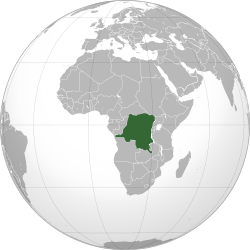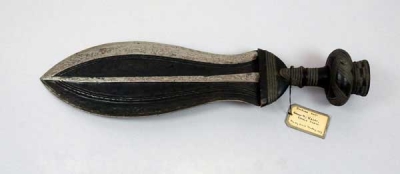Ikul (1907.21.25)
 CongoIkul from the Democratic Republic of Congo, Africa. Collected by Emil Torday. Given to the Museum in 1907.
CongoIkul from the Democratic Republic of Congo, Africa. Collected by Emil Torday. Given to the Museum in 1907.
This short-sword or knife is known as an ikul and was collected in Kasai from the Kuba people. It exhibits a distinctive feature of many Central African blades, which is the Z-shaped or ogee section. The blade is artistically made; it has attractive curved fullers (grooves), and the two blade halves on each side are polished silver and dulled black, respectively, to present a negative mirror image of each other.
Defining Gender
All adult Kuba men carried the ikul in historical times. As occurred in many other cultures, the sword served as a symbol of adult masculinity. The Kuba are notable for their skills in blacksmithing and the importance in which they hold the community's blacksmith. Smithing was (alongside weaving and a select few other arts) considered a royal art. This explains why the bearing of arms was regarded by the Kuba not only as a cultural symbol of class, manhood and warriorhood, but also of kingship.
There are certain kinds of ikul (those bearing a conical pommel) which were first designed and created by King Shyaam aMbul aNgoong in the early 17th century, and which are exclusively carried by those Kuba of the ruling Bushoong clan as a symbol of peaceful reign. That a weapon should serve as a symbol of peace may seem confusing, but this accurately reflects the fact that peace can often only be guaranteed by a government possessing effective military force. However, this example is the more conventional form of ikul, worn by men of the other Kuba clans, which has a flat pommel incised with an attractive interlaced design reminiscent of the weaving seen on Kuba raffia mats.





